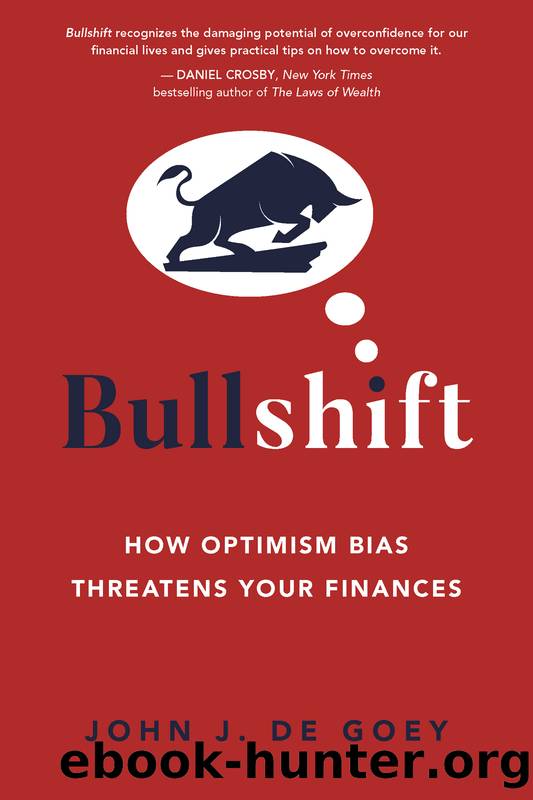Bullshift by John J. De Goey

Author:John J. De Goey
Language: eng
Format: epub
Publisher: Dundurn Press
Canada
-5.8% (1% rate, 6.8% inflation)
U.S.
-7.4% (0.875% rate, 8.3% inflation)
Eurozone
-7.9% (-.5% rate, 7.4% inflation)
U.K.
-8% (1% rate, 9.0% inflation)
Central bankers found themselves way behind the curve and in desperate need of playing catch-up. Inflation was at a thirty-year high and climbing steadily, yet they seemed content to do nothing until the situation became desperate.
By the summer of 2022, the broad-based perpetual bullishness that investors had come to know for the past several decades came face to face with the larger economic imperative of keeping inflation in check, no matter what the consequences might be. From the spring of 2020 until the end of 2021, central bankers were universally accommodative and, as a result, people thought they were being prudent by being bullish. Recency bias was playing games with peopleâs psyches and the collective behaviour of retail investors failed to adjust to the newfound hawkishness of central bankers. Thinking the recent past would be a reliable guide to the foreseeable future, most people chose to stay invested even though markets were dropping and further rate hikes were clearly on the horizon.
So, what have we learned? First, everyone seemed determined to fight the last war. Given that the response to the GFC was too timid, policymakers erred on the side of stronger intervention in 2020. In hindsight, many now think the Covid-19 response would have been best for the GFC and the GFC response best for Covid-19. Both were correct in direction and both more or less worked, but the appropriate interventions for each seem to have been switched. Even the right policies, if not timed or calibrated properly, can bring a whole new set of problems that policy experts call âunintended consequences.â
The lesson in all this is that central bankers are human, and micromanaging the disparate elements of a modern economy is not for the faint of heart. Many people were pleasantly shocked at how swift and purposeful a central bank (and national government) response to a pandemic can be. The speed and magnitude of the intervention were unprecedented in every way. That response, in turn, led to a massive run-up in asset prices for virtually all asset classes. It also exacerbated several challenging socio-economic conditions that had been lingering just below the surface. There is little doubt that the easy money policies of central bankers not only gave rise to inflation, but also fuelled populism, as well as social and income inequality. Markets boomed because central bankers provided an environment that allowed them to boom. A degree of cognitive dissonance took hold and no one wanted the party to end, so central bankers were late in taking away the punch bowl. But even great parties must end eventually.
Download
This site does not store any files on its server. We only index and link to content provided by other sites. Please contact the content providers to delete copyright contents if any and email us, we'll remove relevant links or contents immediately.
| Analysis & Strategy | Bonds |
| Commodities | Derivatives |
| Futures | Introduction |
| Mutual Funds | Online Trading |
| Options | Portfolio Management |
| Real Estate | Stocks |
Rich Dad Poor Dad by Robert T. Kiyosaki(6413)
Pioneering Portfolio Management by David F. Swensen(6229)
How To Win Friends and Influence People by Dale Carnegie(4447)
The Money Culture by Michael Lewis(4082)
The Dhandho Investor by Mohnish Pabrai(3705)
The Wisdom of Finance by Mihir Desai(3658)
Liar's Poker by Michael Lewis(3372)
Fooled by Randomness: The Hidden Role of Chance in Life and in the Markets by Nassim Nicholas Taleb(3048)
The ONE Thing by Gary Keller(3010)
The Intelligent Investor by Benjamin Graham Jason Zweig(2995)
Mastering Bitcoin: Programming the Open Blockchain by Andreas M. Antonopoulos(2982)
Rich Dad Poor Dad: What The Rich Teach Their Kids About Money - That The Poor And Middle Class Do Not! by Robert T. Kiyosaki(2909)
How to Day Trade for a Living: Tools, Tactics, Money Management, Discipline and Trading Psychology by Andrew Aziz(2909)
Investing For Dummies by Eric Tyson(2894)
How to Win Friends and Influence People by Dale Carnegie(2863)
Market Wizards by Jack D. Schwager(2645)
The Psychology of Money by Morgan Housel(2632)
Zero Hour by Harry S. Dent Jr. & Andrew Pancholi(2614)
How to Pay Zero Taxes, 2018 by Jeff A. Schnepper(2602)
